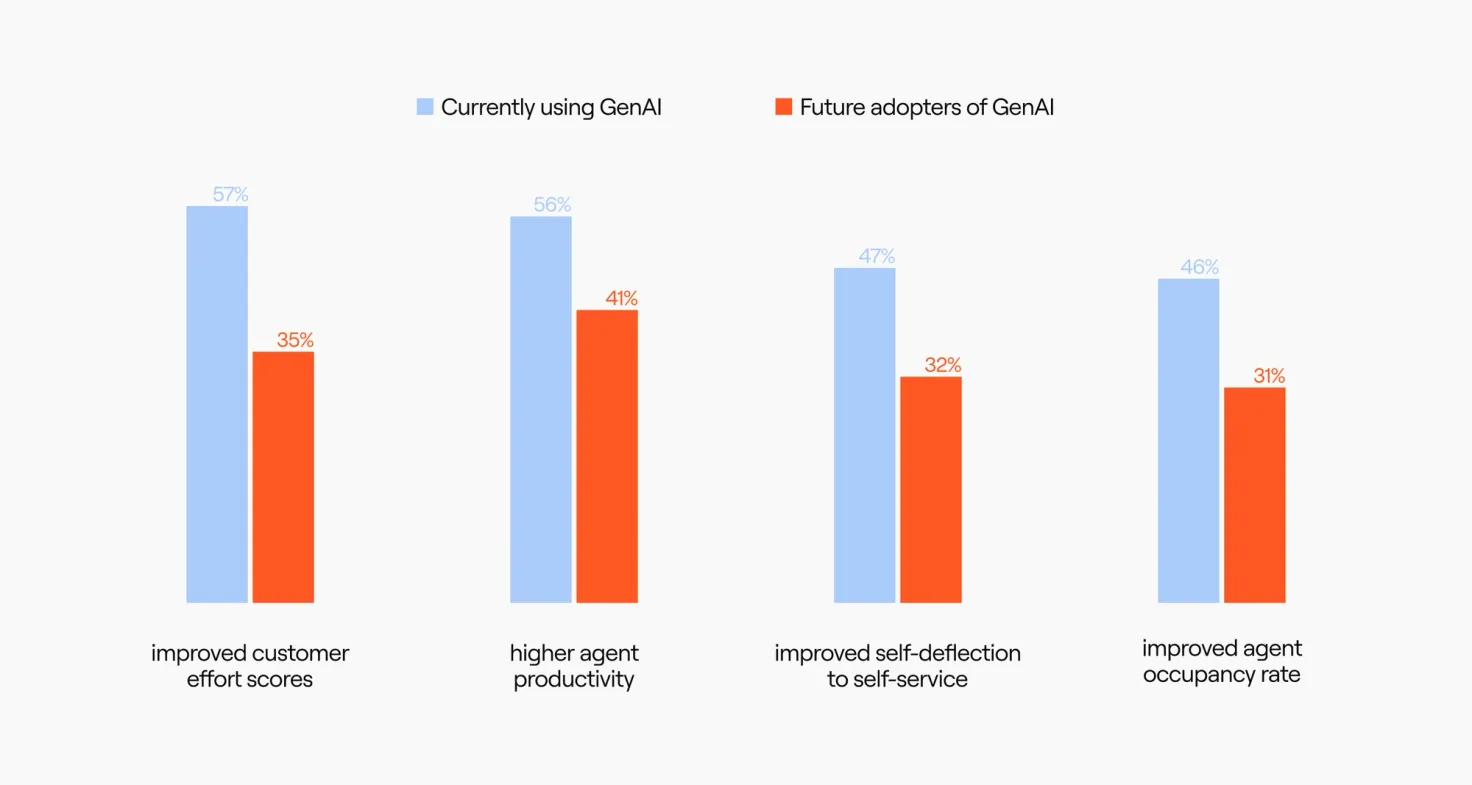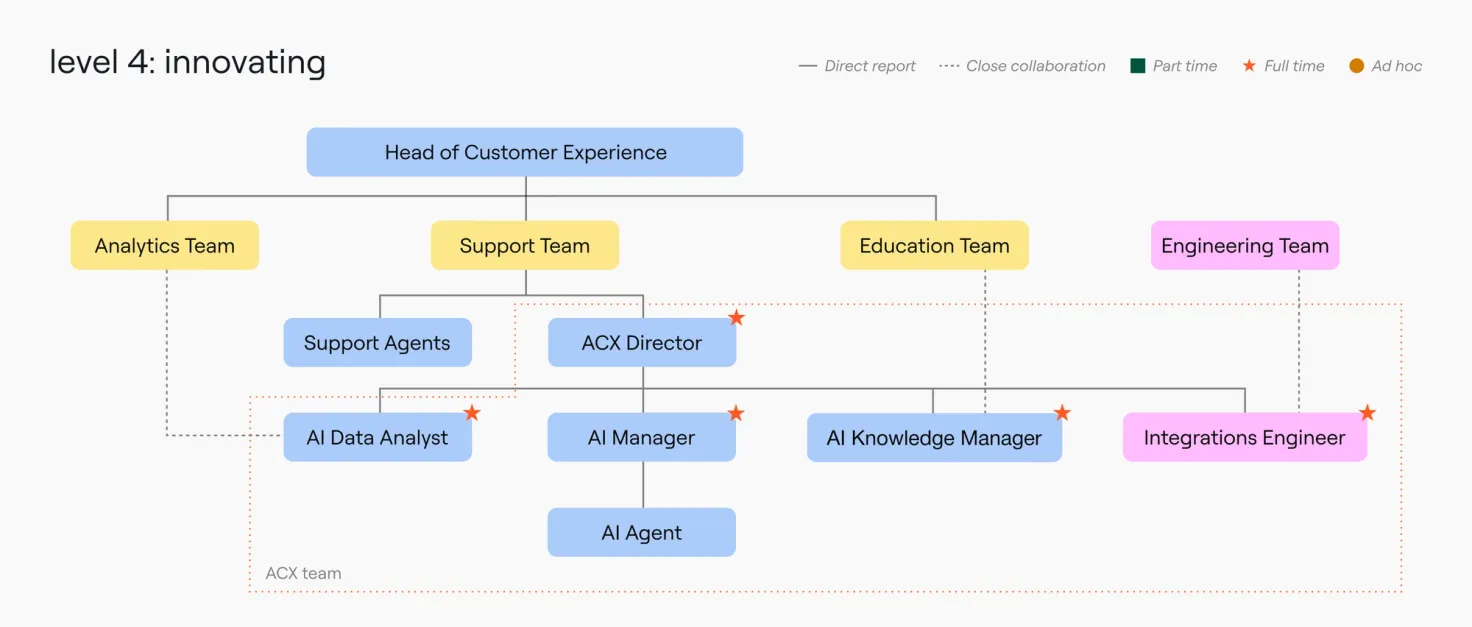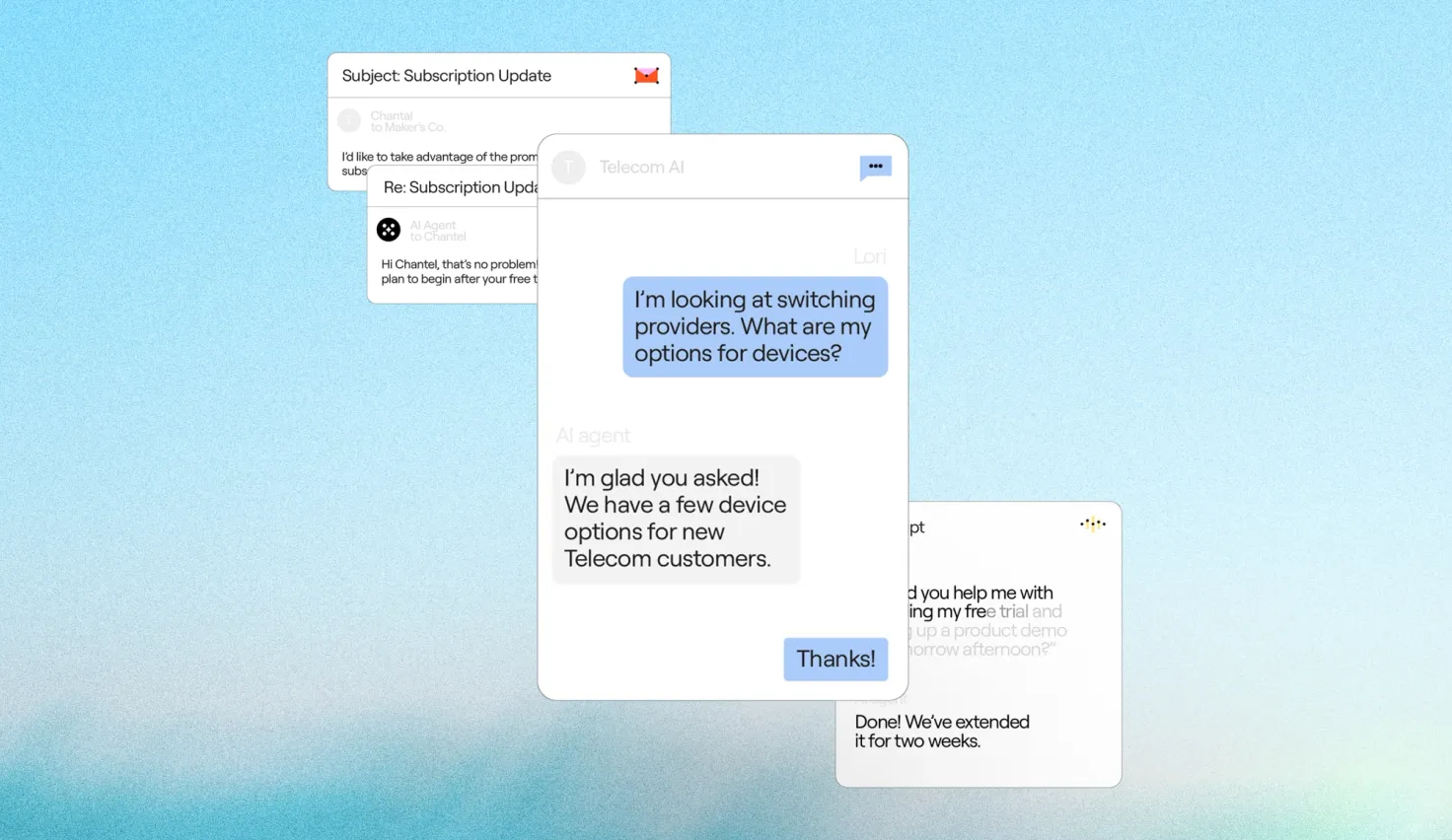
Phase Zero: How to build the business case for upgrading to an AI Voice agent
Get access to this exclusive session on-demand and discover how to turn every customer conversation into a competitive advantage.
Learn More

If your support team is built around headcount instead of automation, sorry to say it, but you’re already behind.
Customer service costs are climbing. Ticket volumes are breaking new records. And customers? They're demanding faster, more personalized experiences than ever. Hiring humans to keep up isn’t the fix—it’s a fast track to burnout and budget blowouts.
But rest easy, there is a solution: build a team that knows how to use AI. This will enable your CX to scale without constantly hiring during peak times and inevitably scaling back when things slow down.
And although AI tools come with a price tag, this cost isn’t linear. Unlike human agents, AI doesn’t need a bigger paycheck to handle more tickets. Once trained and integrated, your AI agent can scale effortlessly, handling 10 conversations or 10,000 with near-zero marginal cost.
You’ll still need humans, but not to chase volume. Their value shifts from answering questions to improving systems and delivering an extraordinary customer experience at every turn.
Conversational AI tools improved issues resolved per hour by 14% within the customer service department of a Fortune 500 company.
- NBER
This guide shows you how to structure, staff, and scale a customer service team designed for the AI-first customer service era. One that’s more efficient and more customer-centric.
It’s not a team with AI tacked on. It’s a team built around it.
An AI customer service team is made up of humans who manage, coach, and continuously improve an AI agent that handles most customer interactions. They don’t just set it and forget it. They tune it like a top performer.
The AI agent takes care of the day-to-day conversations, while the team focuses on strategy, systems, and scale. The result? 24/7 support that improves over time (not just works overtime) and delivers faster, more consistent experiences to customers.
This isn’t about replacing people. It’s about repurposing your team for bigger impact, and empowering AI to handle the high-volume, high-urgency work, freeing up your human team to focus on what actually improves satisfaction and loyalty.
The best time to build this team was yesterday. The next best? Before your competitors do. And if the data’s any indication, early adopters are already pulling ahead.

AI might be handling the bulk of conversations, but it’s your human team that makes sure it performs like a pro.In an AI customer service team, the roles don’t disappear. They evolve.
Instead of managing queues and chasing tickets, your support team now manages quality, systems, and scale. These roles ensure your AI agent is trained, trusted, and continuously improving—not just to reduce costs, but to deliver better experiences.
Here’s what a modern AI support function looks like:

We’ll break down each role below, and later, show how they come together to run a high-performing AI-first support model.
The AI agent is your new frontline rep: your most consistent, scalable, and coachable team member. It delivers five-star experiences at high volume, around the clock, without burnout, missed shifts, or off days.
This isn’t just automation. It’s performance at scale.
An AI agent handles high-volume, high-frequency inquiries across channels, delivering fast, consistent, 24/7 support. Order status? Return policy? Troubleshooting? The AI agent's got it covered.

But not all AI agents are created equal. Some sound confident, but get it wrong. Others are stubborn and hard to improve.
The best AI agents are different: they’re trained to learn fast, adapt quickly, and get smarter with every interaction. They’re not just accurate, they’re coachable. And that makes all the difference.
Choosing the right AI agent is foundational to your customer service team structure. Look for one that’s safe, reliable, and designed to improve, not just operate.
Download this guide to understand the difference between chatbots and AI agents and discover the 8 success criteria that you should be testing AI agents on.
Get the guide
The AI Manager is the operational lead for your AI agent. This person owns the training, performance tuning, and day-to-day quality assurance.
They train the AI, fine-tune its workflows, and monitor its performance to boost metrics like AR%, CSAT, and escalation rate. When things drift off course (and they will), the AI manager gets them back on track.

Their biggest challenge? Drift. As your product, policies, or customer language evolve, the AI can lose its edge. It’s the AI manager’s job to catch that early and adjust.
Great AI managers work in sprints: reviewing transcripts, tagging breakdowns, and constantly improving response quality. Without them, your automation stagnates.
The knowledge manager owns the AI agent’s brain and keeps it sharp.
They create, structure, and maintain the content your AI agent relies on to deliver accurate answers. If the knowledge is outdated, fragmented, or poorly written, your AI support breaks down fast.
If you have a knowledge manager, chances are you also have a dedicated knowledge base. That’s table stakes.
What really moves the needle? Giving that knowledge manager the insight and tools to continuously improve content quality based on real customer interactions.
That’s where tools like Topics and Recommendations come in. They surface where your AI is struggling to respond, where customers are getting confused, and where content updates could drive better outcomes—like higher AR% and CSAT.
The best knowledge managers don’t just maintain content. They evolve it in lockstep with your product, policies, and customer needs.
Without them, your AI agent is just guessing.
The Director of ACX is your AI support team’s north star. They lead the shift from a human-heavy model to one that’s AI-first by setting strategy, securing cross-functional buy-in, and aligning automation goals with business outcomes.
They’re responsible for everything from selecting the right vendor to defining success metrics and rallying internal teams. And with the right partner, building an AI agent doesn’t have to be slow or complex.
The implementation can be fast, focused, and impactful, especially when the Director of ACX is steering the vision.
One of their superpowers? Setting clear, milestone-based goals that turn ambition into action.AI might be new for your org, but it doesn’t have to be vague. When this role defines what success looks like in the first 30, 60, and 90 days, it builds confidence across the business and keeps momentum high.
And perhaps most importantly, they make the case for why AI-first customer service deserves attention now. This isn’t just another support project. It’s a strategic lever for growth, efficiency, and customer loyalty.
The Director of ACX ensures the business sees that, and stays committed to it.
Watch Ada's spring product launch to experience the most human AI in action, watch live demos of an AI agent learning and adapting, and explore how Ada tackles complex support scenarios with empathy and intelligence.
Watch now
Every high-performing AI customer service team has a trio of unsung heroes: analysts, ops leads, and technical owners.
But the biggest barrier they face isn’t tech. It’s priorities.
With limited time and growing demands, why should they invest in AI-first CX? Because when these roles align behind the right initiative, they drive transformational change.
It’s up to the broader team to show the value: how better automation leads to fewer tickets, lower costs, and more bandwidth for innovation across the org. Data helps tell that story. Real-time insights, surfaced by the analyst and powered by solid integrations, show exactly where AI is working—and where it’s ready to do more.
When these teams are empowered and aligned, AI doesn’t just get implemented. It delivers.
Start with a systems audit. Prioritize integrations that fuel resolution, and don’t be afraid to use middleware or iPaaS tools to bridge the gaps. Clean data = smarter automation.
There’s no one-size-fits-all structure for an AI customer service team. But there is a clear path to maturity, and the best support leaders know where they are on that journey.
Below are the three core operating models. Each one reflects a different level of AI adoption, risk tolerance, and internal capability. The more mature the model, the more efficient and scalable your customer service team becomes.
Watch this webinar on demand to discover the benefits of AI maturity, assess your maturity level, and find out what you need to do to level up.
Watch now
This is where many teams start. AI is in the room, but it’s not on the front lines.
Your AI support agent assists behind the scenes: tagging tickets, routing inquiries, drafting replies for agent approval. It’s not interacting with customers directly.
Team structure:
Best for: Brands just starting with AI, or teams with limited training data.
Watch out for: Limited upside. If your AI agent isn’t interacting with customers, it can’t learn or drive real value. This is a good entry point, but not a long-term strategy.
In this model, your AI agent is live with customers, handling real conversations and resolving issues independently.
Human agents are still critical, but they handle exceptions, emotional cases, or high-stakes scenarios. Think of this as a true AI-human partnership.
Team structure:
Best for: Mid-sized to mature support teams with strong knowledge bases and a need to scale 24/7 coverage.
Why it works: You’re no longer scaling linearly with headcount. The AI agent absorbs the bulk of tier 1 volume—and your team spends less time reacting and more time improving.
Here, your AI agent is the frontline. It resolves 80%+ of all interactions. Human agents only step in for truly complex or uncommon scenarios.
You don’t just have automation, you have a high-performing, AI-first customer service team structure that scales globally and runs continuously.
Team structure:
Best for: High-volume, low-complexity businesses (e.g. eCommerce, SaaS, marketplaces)—or any team ready to treat AI like a teammate, not a tool.
The payoff: Lower costs. Higher CSAT. Real-time resolution at global scale.
Your team might be smaller in an AI-first structure, but they’re more strategic than ever.
Here’s what an AI customer service team actually does behind the scenes to deliver fast, high-quality support at scale.
Your AI agent doesn’t come preloaded with your policies or brand voice. The team needs to train it.
Who’s involved:
Done right, setup isn’t just a one-time launch—it’s the foundation for long-term performance.
AI isn’t “set and forget.” It needs constant oversight.
What to track:
Who’s involved:
If your AR% is high but CSAT is low, you’ve got a quality issue. If CPC is high, you’re overengineering without impact.
Even the best AI agents need coaching . That means auditing transcripts, tagging issues, and refining prompts or logic.
Who’s involved:
It’s not just maintenance—it’s how your AI gets smarter with every interaction.

Sometimes the AI agent needs help. How cleanly it hands off to humans makes or breaks the experience.
Who’s involved:
Smooth escalation isn’t just reactive—it’s a key input to AI training and customer satisfaction.
Integration and automation scaling
The more data the AI agent can access, the more it can do. Real-time order info. Account history. Policy rules. It all matters.
Who’s involved:
Integrations unlock better automation. Better automation drives better experiences—and serious savings.
Download this guide to get a practical framework for choosing an AI agent platform that integrates and improves over time.
Get the guide
Program advocacy and expansion
AI doesn’t stop at one channel or one region. It’s a new operating model for CX—and the Director of ACX is responsible for scaling it across the business.
Who’s involved:
What they do:
This isn’t just support transformation. It’s a company-wide shift, and it needs a leader to champion it.
You’re not hiring to fill seats anymore. You’re building a team to scale AI.
In an AI-first model, your customer service team structure changes, and so do the skills you need. The best support hires today aren’t just empathetic. They’re systems thinkers, analysts, and process designers.
Agentic AI will autonomously resolve 80% of common customer service queries without human intervention by 2029 and reduce operational costs by 30%.
- Gartner
Let’s look at what hiring and upskilling look like in the AI-first era .
Traditional CX roles focused on speed, empathy, and endurance. But in an AI-led support team, the job shifts from closing tickets to preventing them.
Look for people who:
They don’t just help customers—they help the AI help customers.
AI doesn’t eliminate your support team. It evolves it. In an AI-first environment:
Instead of being buried in reactive work, your team becomes a proactive force—preventing problems before they reach the queue.
Modern support pros don’t just need people skills, they need AI fluency. Key capabilities include:
Bonus if they know how to speak “product” or collaborate with engineering. Cross-functional fluency is gold.
Customer service isn’t getting simpler. It’s getting more expensive, more complex, and more expected—everywhere, all the time. Customers want faster responses, consistent experiences, and support that actually solves their problem, not another wait in the queue.
The only way to keep up isn’t more agents. It’s a smarter model. An AI-first support function gives you:
But AI doesn’t run itself. Behind every high-performing AI support agent is a team that coaches, trains, and improves it.
And that team doesn’t look like your old one.
Don’t let an outdated team structure hold you back. Start building a customer service team that uses both AI and human agents to their fullest potential.
Get the guide